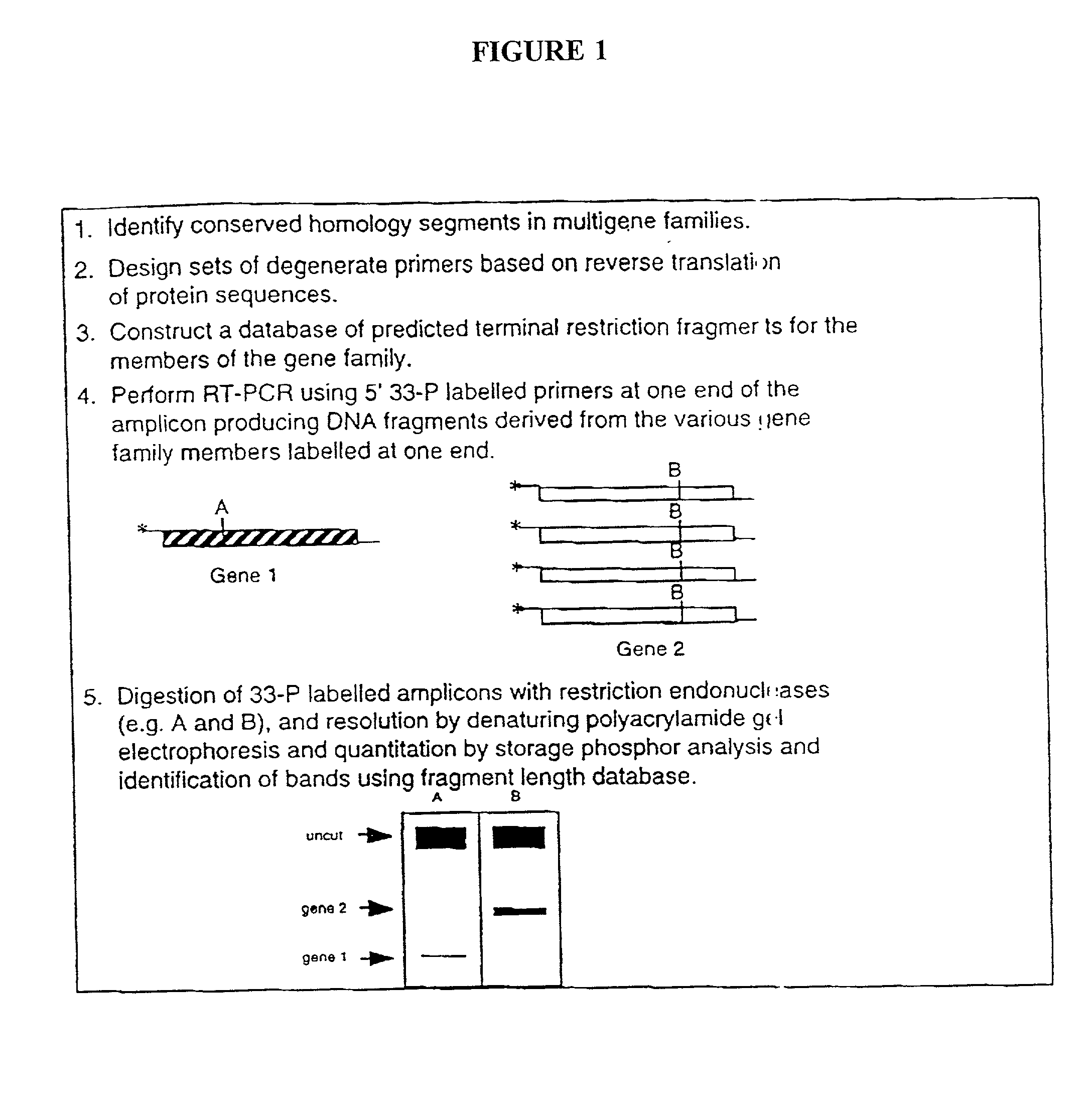Analysis of gene family expression
a gene family and gene technology, applied in the field of gene family expression analysis, can solve the problems of limited signal in hybridization based methods, inability to quickly assign signals produced by differential displays to specific genes, etc., and achieve the effect of eliminating cumbersome cloning and sequencing strategies
- Summary
- Abstract
- Description
- Claims
- Application Information
AI Technical Summary
Benefits of technology
Problems solved by technology
Method used
Image
Examples
example 1
Identification of Conserved Homology Segments in Multigene Families
[0145] Prior to developing degenerate primer sets, conserved motifs in the targeted gene family are identified. Generally, motifs of five codons or longer, and typically five to seven codons, with spacing of 0.1 to 2 kilobases are selected. Motifs can be identified by comparing sequences of a multiple members of gene family. The identification of conserved sequences from a representative set of the gene family allows for the generation of degenerate primers that will amplify all members of the family. Existing on-line databases of protein structure and sequence similarity such as PROSITE (http: / / www.ebi.ac.uk / searches / prosite.html), Blocks (http: / / www.blocks.fhcrc.org), Prints (http: / / www.biochem.ucl.ac.u-kibsm / dbbrowser / prints), ProDom (http: / / protein.toulouse.inra.fr / prodom.ht-ml) and Pfam (http: / / genome.wustl.edu / eddy / pfam / welcome.html) (D'Esposito et al., Hum. Mol. Genet. 3, 735 [1994]) offer a large battery of c...
example 2
RAGE Analysis of Tyrosine Kinases
[0155] I. General RT-PCR
[0156] RNA was isolated by a guanidine isothiocyanate method as described by Chirgwin et al. (Biochemistry 18, 5294 [1979]), although any RNA isolation means is contemplated by the present invention. Fifty micrograms of total cellular RNA was used for reverse transcription, with oligo (dT).sub.12-18 as primers. The reaction conditions were as described by Wainstein et al. (Cancer Res. 23, 6049 [1995]). PCR was carried out in 10 mM Tris-HCl (pH 9.3), 50 mM KCl, 2.5 mM MgCl.sub.2, 0.1% TRITON X-100, and 200 .mu.M concentrations of each deoxynucleotide triphosphate for 30 cycles, with a cycle profile of 50 seconds at 95.degree. C., 2 minutes at 60.degree. C., and 2 minutes at 72.degree. C., followed by a 7 minute extension at 72.degree. C., using appropriate amplification primers. PCR products were analyzed by 4% PAGE.
[0157] II. RT-PCR Profiling of Tyrosine Kinases
[0158] The RNA isolation and cDNA synthesis were conducted as desc...
example 3
Generation of Expression Profile Database
[0167] To facilitate widespread use of the RAGE, databases should be created to allow interpretation of the restriction fragment data collected. The tyrosine kinase database that has been constructed can be further completed by three methods. The first will be inclusion of EST sequence data for tyrosine kinase genes for which a complete cDNA has not been reported. This will be accomplished by both keyword and homology search methods and is straightforward. The second method is by cloning and sequencing the unidentified bands that appear in the analysis of the 60 NCI cancer lines. The present invention provides an efficient method for this. The method is based on RACE cDNA cloning procedures (Chenchik et al., Biotechniques 21, 526 [1996]; and Frohman et al., Proc. Natl. Acad. Sci. 85, 8998 [1988]) and works for fragments that appear in any restriction enzyme digest regardless of terminal structure of the cleavage site. This method has been use...
PUM
| Property | Measurement | Unit |
|---|---|---|
| Tm | aaaaa | aaaaa |
| temperature | aaaaa | aaaaa |
| temperature | aaaaa | aaaaa |
Abstract
Description
Claims
Application Information
 Login to View More
Login to View More - R&D
- Intellectual Property
- Life Sciences
- Materials
- Tech Scout
- Unparalleled Data Quality
- Higher Quality Content
- 60% Fewer Hallucinations
Browse by: Latest US Patents, China's latest patents, Technical Efficacy Thesaurus, Application Domain, Technology Topic, Popular Technical Reports.
© 2025 PatSnap. All rights reserved.Legal|Privacy policy|Modern Slavery Act Transparency Statement|Sitemap|About US| Contact US: help@patsnap.com



